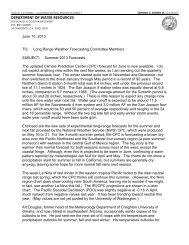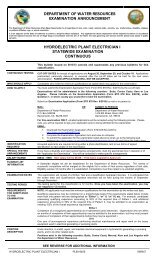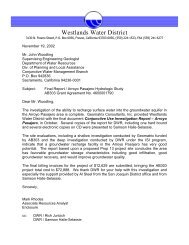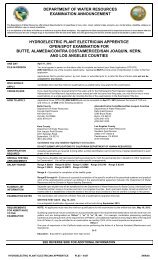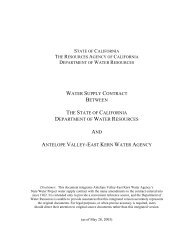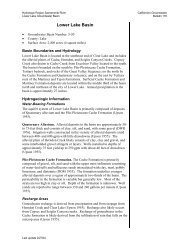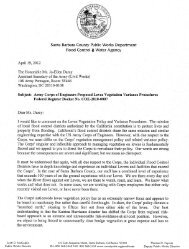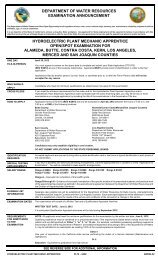Bulletin 1.pdf - California Department of Water Resources - State of ...
Bulletin 1.pdf - California Department of Water Resources - State of ...
Bulletin 1.pdf - California Department of Water Resources - State of ...
You also want an ePaper? Increase the reach of your titles
YUMPU automatically turns print PDFs into web optimized ePapers that Google loves.
WATER RESOURCES OF CALIFORNIA 465<br />
content. Boron is also present in significant amounts in ground waters<br />
<strong>of</strong> Cache Creek Basin.<br />
West-side ground waters in the San J oaquin Valley are characterized<br />
by high percentage <strong>of</strong> sulphate and abnormal amounts <strong>of</strong> boron,<br />
<strong>of</strong>ten in toxic concentrations. Nearly all have a brackish taste and many<br />
are unpalatable. The predominating sulphate radical usually has a concentration<br />
below the upper limit <strong>of</strong> safe use for irrigation. The usable<br />
zone <strong>of</strong> pumping on the west side <strong>of</strong> the San Joaquin Valley from Mendota<br />
to Buttonwillow is generally found between overlying unusable<br />
perched water, underlying brines, and a more or less effective impervious<br />
stratum in the trough <strong>of</strong> the valley, commonly known as the Mendenhall<br />
Dike. Calcium and magnesium are dominant bases in both east-side and<br />
west-side ground waters. These bases are generally subordinated by<br />
sodium toward the trough <strong>of</strong> the valley, from Sutter Basin south to<br />
Buena Vista Lake. Chloride is <strong>of</strong>ten the principal acid radical in axial<br />
ground waters, although bicarbonate concentrations remain high. In the<br />
trough <strong>of</strong> the San Joaquin Valley, ground waters between depths <strong>of</strong><br />
about 300 feet and about 1,000 feet generally are lower in mineral content<br />
than are shallow waters. Axial ground waters are characterized by<br />
diverse composition and concentration <strong>of</strong> salts.<br />
GROUND WATER STORAGE CAPACITY OF SACRAMENTO VALLEY<br />
For some years the <strong>State</strong> <strong>of</strong> <strong>California</strong> has cooperated with the<br />
United <strong>State</strong>s Geological Survey in ground water investigations, and<br />
the results have been published in numerous reports <strong>of</strong> the Geological<br />
Survey. A summary <strong>of</strong> a recent unpublished report entitled" Ground<br />
<strong>Water</strong> Storage Capacity <strong>of</strong> the Sacramento Valley, <strong>California</strong>," by J. F.<br />
Poland and others, dated November 1949, appears in this bulletin as<br />
Appendix D.



